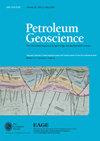Hierarchical parameterization and compression-based object modelling of high net:gross but poorly amalgamated deep-water lobe deposits
IF 2.1
4区 地球科学
Q3 GEOSCIENCES, MULTIDISCIPLINARY
引用次数: 6
Abstract
Deep-water lobe deposits are arranged hierarchically and can be characterized by high net:gross ratios but poor sand connectivity due to thin, but laterally extensive, shale layers. This heterogeneity makes them difficult to represent in standard full-field object-based models, since the sands in an object-based model are not stacked compensationally and become connected at a low net:gross ratio. The compression algorithm allows the generation of low-connectivity object-based models at high net:gross ratios, by including the net:gross and amalgamation ratios as independent input parameters. Object-based modelling constrained by the compression algorithm has been included in a recursive workflow, permitting the generation of realistic models of hierarchical lobe deposits. Representative dimensional and stacking parameters collected at four different hierarchical levels have been used to constrain a 250 m-thick, 14 km2 model that includes hierarchical elements ranging from 20 cm-thick sand beds to more than 30 m-thick lobe complexes. Sand beds and the fine-grained units are represented explicitly in the model, and the characteristic facies associations often used to parameterize lobe deposits are emergent from the modelling process. The model is subsequently resampled without loss of accuracy for flow simulation, and results show clearly the influence of the hierarchical heterogeneity on drainage and sweep efficiency during a water-flood simulation.基于分层参数化和压缩的高网:粗大但混杂程度较差的深水叶状矿床目标模拟
深水凸角矿床按层次排列,其特征是净:毛比率高,但由于薄但横向扩展的页岩层,砂连通性差。这种异质性使得它们很难在标准的基于对象的全场模型中表示,因为基于对象的模型中的沙子不是补偿堆叠的,而是以低净毛比连接的。压缩算法允许在高净:毛比率下生成基于对象的低连通性模型,方法是将净:毛和合并比率作为独立的输入参数。受压缩算法约束的基于对象的建模已包含在递归工作流中,允许生成分层叶沉积物的真实模型。在四个不同层次收集的代表性尺寸和堆叠参数已用于约束250 m厚,14 km2模型,包括20个层次元素 cm厚至30以上的砂层 m厚的瓣复合体。模型中明确表示了砂层和细粒单元,建模过程中出现了通常用于参数化凸起沉积物的特征相组合。随后,在不损失流量模拟精度的情况下对该模型进行了重新采样,结果清楚地表明了在洪水模拟过程中,层次不均匀性对排水和冲刷效率的影响。
本文章由计算机程序翻译,如有差异,请以英文原文为准。
求助全文
约1分钟内获得全文
求助全文
来源期刊

Petroleum Geoscience
地学-地球科学综合
CiteScore
4.80
自引率
11.80%
发文量
28
审稿时长
>12 weeks
期刊介绍:
Petroleum Geoscience is the international journal of geoenergy and applied earth science, and is co-owned by the Geological Society of London and the European Association of Geoscientists and Engineers (EAGE).
Petroleum Geoscience transcends disciplinary boundaries and publishes a balanced mix of articles covering exploration, exploitation, appraisal, development and enhancement of sub-surface hydrocarbon resources and carbon repositories. The integration of disciplines in an applied context, whether for fluid production, carbon storage or related geoenergy applications, is a particular strength of the journal. Articles on enhancing exploration efficiency, lowering technological and environmental risk, and improving hydrocarbon recovery communicate the latest developments in sub-surface geoscience to a wide readership.
Petroleum Geoscience provides a multidisciplinary forum for those engaged in the science and technology of the rock-related sub-surface disciplines. The journal reaches some 8000 individual subscribers, and a further 1100 institutional subscriptions provide global access to readers including geologists, geophysicists, petroleum and reservoir engineers, petrophysicists and geochemists in both academia and industry. The journal aims to share knowledge of reservoir geoscience and to reflect the international nature of its development.
 求助内容:
求助内容: 应助结果提醒方式:
应助结果提醒方式:


